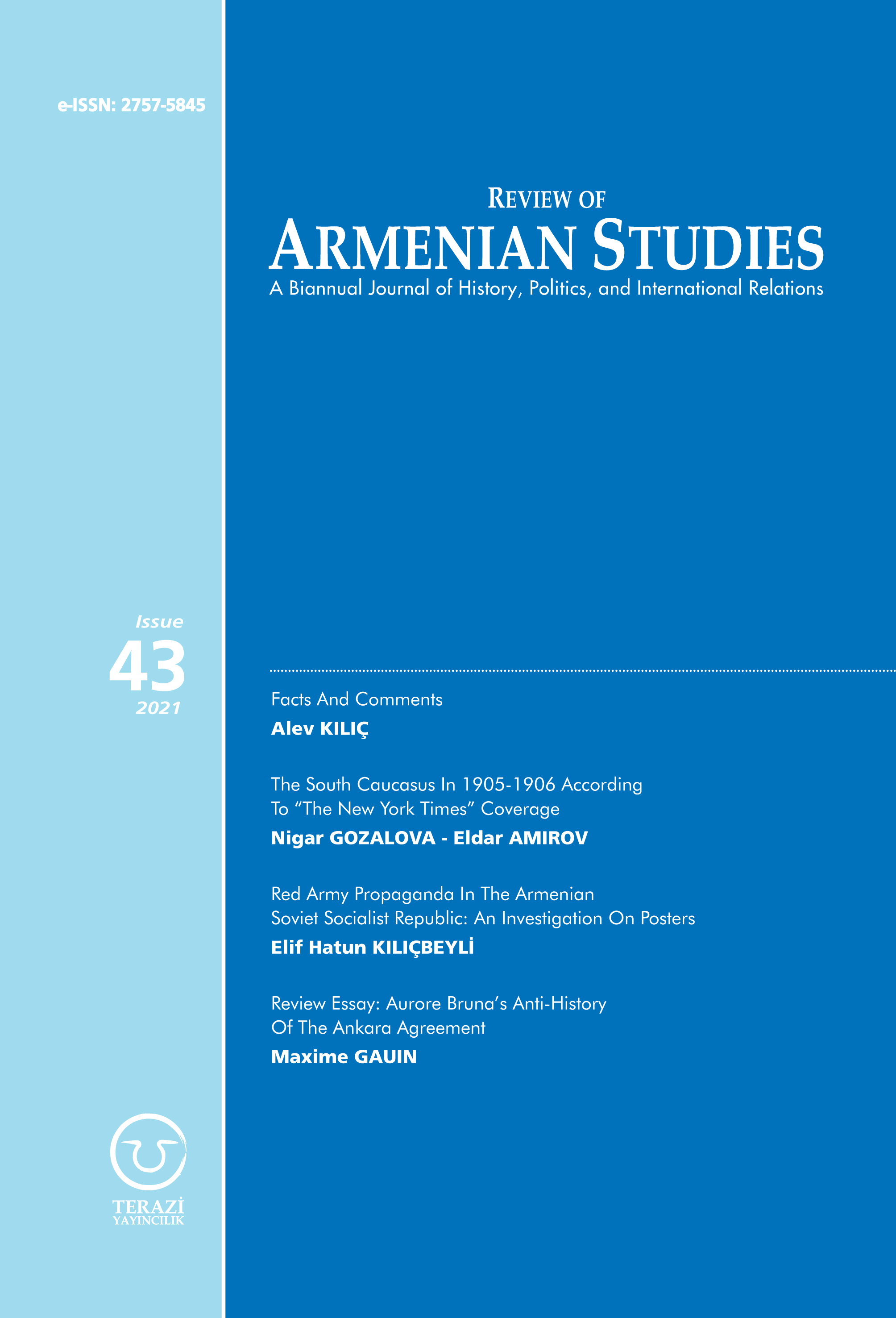Download PDF :


The newly published 43rd issue of the Review of Armenian Studies journal contains 4 articles.
The first article in the 43rd issue, titled “Facts and Comments” and authored by Alev Kılıç, covers Turkey-Armenia relations as well as domestic and international developments of Armenia in the period of January-July 2021. During this period, Armenia endured serious internal instability caused by the outcomes of the 2020 Karabakh War. Amidst this instability, the Armenian government vacillated between adopting a realist and peaceful policy based on regional cooperation and a surrealist and revanchist one. The consequences of the defeat in the war against Azerbaijan further increased Armenia’s dependence on Russia, narrowing its margin of double play between Russia and the West. Although the war and the following ceasefire agreement testified to the fact that Karabakh is part of the territory of Azerbaijan and that the question of status is confined solely to the question of what rights are to be accorded to the Armenian minority living in Karabakh, Armenia nevertheless continued in its contacts with the West to plea for sovereignty over Karabakh. The West did not surprise and once again unscrupulously sided with and further encouraged the Armenian narrative. Meanwhile, Turkey continues to be seen as an enemy, but the search for regional cooperation and neighborly relations with acknowledged benefits has gained prominence in the agenda. The internal instability and heavy criticism of the Armenian government led to snap elections, resulting in a landslide victory for Prime Minister Nikol Pashinyan.
In their article titled “The South Caucasus In 1905-1906 According To ‘The New York Times’ Coverage”, Nigar Gozalova and Eldar Amirov evaluate the news coverage received by the Armenian-Azerbaijani Turkish clashes that took place in the South Caucasus in the years 1905-1906. For this, the authors chose the New York Times (NYT) newspaper due its position as one the leading newspapers of that time (a position it continues to enjoy today). This evaluation enables the authors to understand how the clashes were portrayed to and perceived by the public, especially in the West. It is revealed in the article that the NYT closely followed the events related to the clashes and produced numerous reports. However, the article also reveals that the reports were not objective, because despite the numerous facts cited about the complex nature of the clashes and significant casualties on both sides, the Azerbaijani Turks were still portrayed as the main culprits. The western mentality behind such unfair coverage of ethnic clashes persists to this day, as we have witnessed in the unfair treatment Azerbaijan received during the 2020 Karabakh War against Armenia and its efforts to retake the lands occupied for years by Armenia.
In her article titled “Red Army Propaganda In The Armenian Soviet Socialist Republic: An Investigation On Posters”, Elif Hatun Kılıçbeyli uses a special analytical method called “semiotic model” to analyze Soviet era posters meant to glorify the Red Army and Armenia’s forceful incorporation to the Soviet Union. Kılıçbeyli first delves into the formation of the Red Army and what is to be understood from the words “ideology” and “propaganda”. Forming this historical and theoretical context, the author proceeds to analyze Soviet era posters to uncover the explicit and implicit meanings they were meant to convey to their audience and the effects they were meant to have on them. The author’s analysis reveals that, through the Red Army propaganda posters, Soviet authorities sought to explain the ideological purpose of the Red Army's incorporation of Armenia into the Soviet Union and emphasized the Red Army’s “indispensable” role in ensuring the internal and external security of the Union.
In his review essay titled “Aurore Bruna’s Anti-History Of The Ankara Agreement”, Maxime Gauin evaluates the 2018 book version of the Chair of the Armenian General Benevolent Union (AGBU) of Marseille, Aurore Bruna’s master’s thesis titled L’Accord d’Angora de 1921. Théâtre des relations franco-kémalistes et du destin de la Cilicie (English: The Ankara Accord of 1921. Theater of Franco-Kemalist Relations and the Fate of Cilicia). Gauin indicates that the book is “a repetition of most of the [unjustified] traditional grievances of the Armenian nationalists against Turkey, the French diplomacy, and the large majority of the French press in 1920-1923.” He points out that the book contains several factual errors and the misreading of the way events unfolded between the Turkish national liberation movement headed by Mustafa Kemal Atatürk, France, and militant Armenian nationalists. Even more serious are some references made by the author herself that, when scrutinized, contradict her own arguments. Gauin thus argues that Bruna’s book cannot be considered a scholarly contribution due to its numerous and substantial flaws, and that it should be viewed as a propagandist, political pamphlet that symbolizes the opposite of what a scholarly historical work should be.
For the page of the Review of Armenian Studies, please visit: https://avim.org.tr/tr/Dergiler/Review-Of-Armenian-Studies
If you wish to subscribe to the journal or buy the new issue, please contact: motulun@avim.org.tr





























